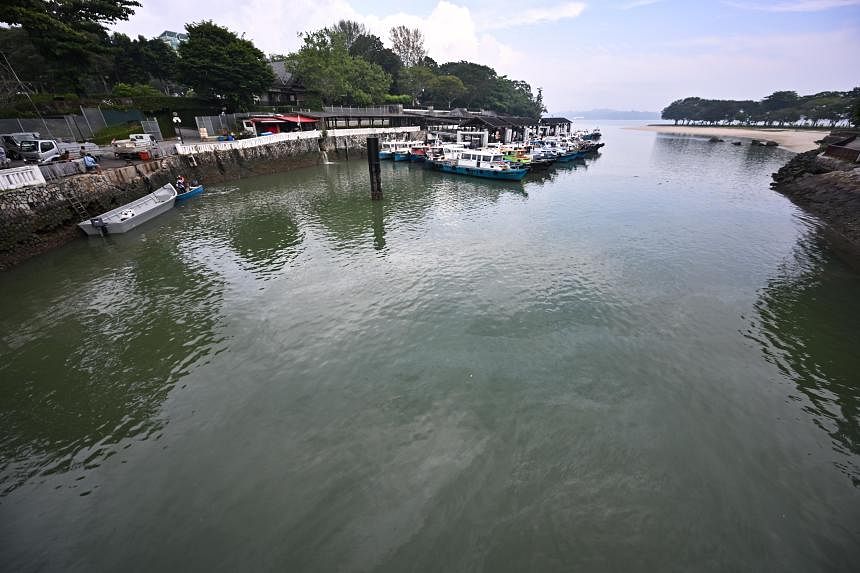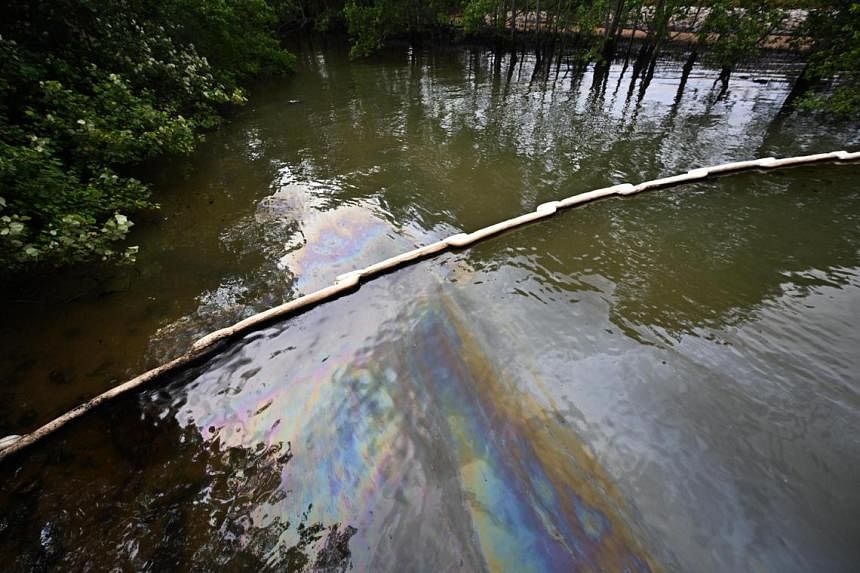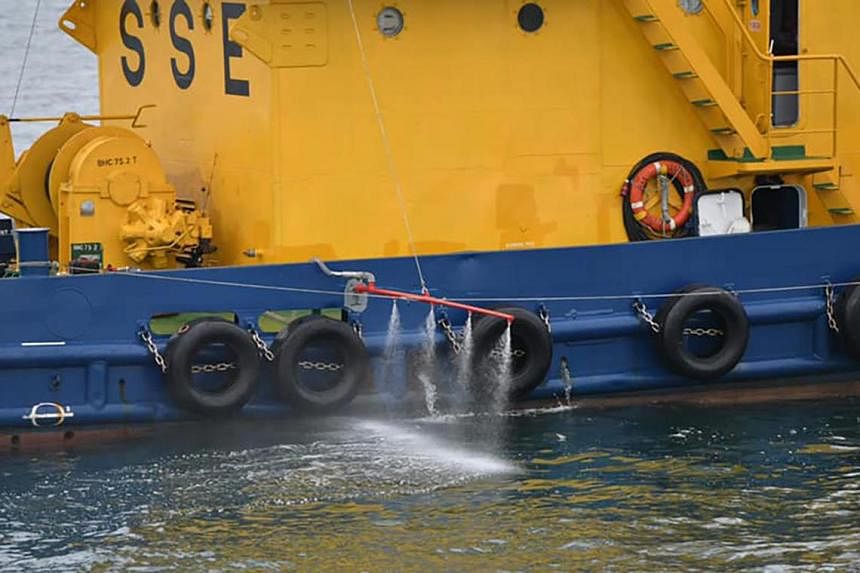ECOCIDE
Singapore Public agencies to replenish stock of absorbent booms, dispersants after oil spill clean-up
Oil sheen on the surface of the water around Changi Point Ferry Terminal at 9.20am on July 8, 2024. ST PHOTO: LIM YAOHUI
Esther Loi
Updated
Aug 11, 2024
SINGAPORE – Weeks after June 14, which saw the worst oil spill in Singapore’s waters in a decade, two public agencies are looking to replenish their stock of absorbent booms and oil spill dispersants.
The National Parks Board (NParks) called for a tender on July 25 for the supply and delivery of absorbent booms covering 1.65km, to replace what was used in cleaning up the recent oil spill.
Separately, a tender was called by the Maritime and Port Authority of Singapore (MPA) on July 24 for the supply and delivery of 24,000 litres of oil spill dispersants to its patrol boats.
MPA will award a three-year contract as part of a routine renewal of its oil spill dispersant stock.
Caused by a collision between Netherlands-flagged dredging boat Vox Maxima and stationary Singapore-flagged bunker vessel Marine Honour at Pasir Panjang Terminal on June 14, the recent oil spill spread to coastlines at East Coast Park, Labrador Nature Reserve, Keppel Bay, the Southern Islands and Sentosa.
Following joint oil spill clean-up operations involving several government agencies that spanned about two months, it was announced that all beaches in Sentosa and East Coast Park would complete their clean-ups by early September.
Sentosa’s Siloso Beach reopened ahead of schedule on Aug 3, while several parts of East Coast Park have also been reopened for land-based activities since July 29.
In tender documents published by NParks on government procurement portal GeBiz, the agency is seeking the supply and delivery of oil spill response kits – including absorbent booms, chemical-protective suits, and disposable bags for hazardous materials – for five locations: Labrador Nature Reserve, Coney Island, Pasir Ris Park, West Coast Park and Sungei Buloh Nature Reserve.
It added that the booms it is sourcing need to be able to absorb at least 200 litres of oil and repel water, and that the kits have to be delivered within four weeks of the agency’s confirmation of the purchase.

Absorbent booms laid out below Bukit Chermin Boardwalk and the mangroves at Berlayer Creek at 5.02pm on June 18, 2024.
ST PHOTO: LIM YAOHUI
Absorbent booms are made from materials that can contain and absorb oil, and were previously used as precautionary measures in biodiversity-sensitive areas including West Coast Park, Chek Jawa Wetlands at Pulau Ubin, Pasir Ris Park and Coney Island Park.
NParks said that it had deployed booms measuring more than 1.5km in length to protect biodiversity-rich coastal and marine habitats, including Berlayer Creek and the Rocky Shore along Labrador Nature Reserve, in the aftermath of the oil spill.
It told The Straits Times in early August that this is part of the agency’s “routine replenishment” of the kits on an ad-hoc basis when needed, since booms had been deployed for oil spill incidents such as the recent one in June.
NParks said: “This is to ensure that key coastal and marine habitats managed by NParks can be protected when the need arises.”
NParks’ tender closed on July 31.
For MPA’s tender involving the supply and delivery of oil spill dispersants, the authority told ST on Aug 8 that this is a “routine renewal” as the current contract for dispersants is expiring, adding that the quantity requested is the same as in previous contracts, and is based on “operational considerations”.
Dispersants are chemicals that break oil up into smaller droplets that can be mixed with water, and are sprayed directly on a spill.
In the June incident, MPA had sprayed these dispersants in the first instance to break down the oil in the immediate vicinity of the affected vessels.

Absorbent booms are made from materials that can contain and absorb oil, and were previously used as precautionary measures in biodiversity-sensitive areas including West Coast Park, Chek Jawa Wetlands at Pulau Ubin, Pasir Ris Park and Coney Island Park.
NParks said that it had deployed booms measuring more than 1.5km in length to protect biodiversity-rich coastal and marine habitats, including Berlayer Creek and the Rocky Shore along Labrador Nature Reserve, in the aftermath of the oil spill.
It told The Straits Times in early August that this is part of the agency’s “routine replenishment” of the kits on an ad-hoc basis when needed, since booms had been deployed for oil spill incidents such as the recent one in June.
NParks said: “This is to ensure that key coastal and marine habitats managed by NParks can be protected when the need arises.”
NParks’ tender closed on July 31.
For MPA’s tender involving the supply and delivery of oil spill dispersants, the authority told ST on Aug 8 that this is a “routine renewal” as the current contract for dispersants is expiring, adding that the quantity requested is the same as in previous contracts, and is based on “operational considerations”.
Dispersants are chemicals that break oil up into smaller droplets that can be mixed with water, and are sprayed directly on a spill.
In the June incident, MPA had sprayed these dispersants in the first instance to break down the oil in the immediate vicinity of the affected vessels.

The vessel-mounted oil dispersant spray system applies oil dispersants swiftly to minimise the environmental impact of oil spills. Pictured here is the system in action from the joint oil spill exercise in 2020.
PHOTO: CHEE HONG TAT/FACEBOOK
The GeBiz tender documents published by MPA show that the appointed contractor must be on standby every day to supply these dispersants within six hours of notification, as long as it is alerted any time between 7am and 7pm.
MPA noted that these dispersants have to comply with industry standards developed by government agencies, academics and industry specialists.
These standards follow guidelines by the International Maritime Organisation – such as recommendations for dispersants not to be used near ecologically sensitive areas, and the need for a test spray run before dispersants are applied entirely to an area – as well as international publications, and took Singapore’s environmental conditions into consideration, it added.
The authority added in the documents that the contract could start tentatively from September. The tender will close on Aug 19.
In response to whether MPA will replenish its booms, MPA said that heavy-duty oil containment booms will be deployed by MPA’s contracted oil spill response vendor Singapore Salvage Engineers, when needed.
Other government agencies involved in the recent oil spill clean-up efforts include the National Environment Agency (NEA) and Sentosa Development Corporation (SDC).
On whether NEA has plans to procure more booms, its spokesperson said that it has an existing contract for the provision of equipment and supplies for landward oil spill clean-ups. Its service provider will replace their stock, including absorbent booms, when required.
SDC said it is “reviewing its existing plans and optimal approaches to safeguard Sentosa against future oil spills”.
The GeBiz tender documents published by MPA show that the appointed contractor must be on standby every day to supply these dispersants within six hours of notification, as long as it is alerted any time between 7am and 7pm.
MPA noted that these dispersants have to comply with industry standards developed by government agencies, academics and industry specialists.
These standards follow guidelines by the International Maritime Organisation – such as recommendations for dispersants not to be used near ecologically sensitive areas, and the need for a test spray run before dispersants are applied entirely to an area – as well as international publications, and took Singapore’s environmental conditions into consideration, it added.
The authority added in the documents that the contract could start tentatively from September. The tender will close on Aug 19.
In response to whether MPA will replenish its booms, MPA said that heavy-duty oil containment booms will be deployed by MPA’s contracted oil spill response vendor Singapore Salvage Engineers, when needed.
Other government agencies involved in the recent oil spill clean-up efforts include the National Environment Agency (NEA) and Sentosa Development Corporation (SDC).
On whether NEA has plans to procure more booms, its spokesperson said that it has an existing contract for the provision of equipment and supplies for landward oil spill clean-ups. Its service provider will replace their stock, including absorbent booms, when required.
SDC said it is “reviewing its existing plans and optimal approaches to safeguard Sentosa against future oil spills”.
No comments:
Post a Comment